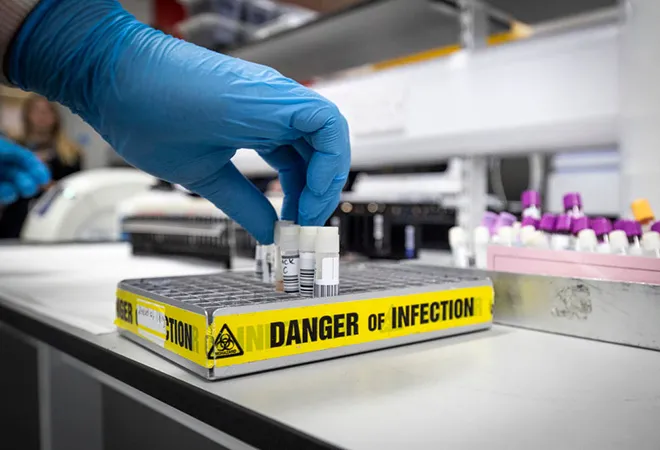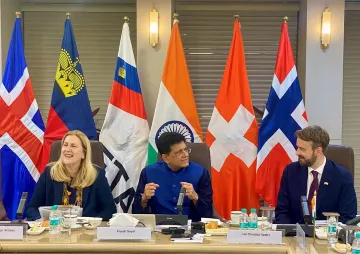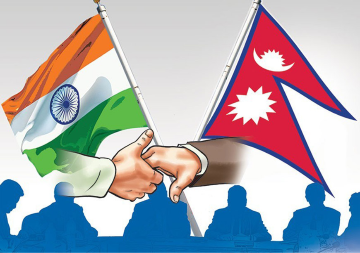
No one can accuse the Indian government of being lax on account of the coronavirus (Covid-19) outbreak. On the very day the WHO declared it to be a pandemic, the government took the drastic step of suspending all visas for entry into India and restricted the arrival of people from abroad. These steps were taken under the directions of a Group of Ministers (GoM) under the
ambit of the 1897 Epidemic Disease Act under which the government can detain people or vessel that comes from abroad.
India has only a few cases right now according to
Lav Aggarwal, Joint Secretary in the Ministry of Health all connected to people who came from abroad. As yet there is no evidence that it has reached the stage of “community spread” where it freely spreads among people who have not travelled or even met anyone from abroad. The government says that more than 1 million people have been screened, but these are the people going through airports. The true extent of the problem would only be indicated if there was larger scale testing of those who have come into contact with those already infected. As of now we have no information on the extent to which these tests have been carried out.
Given the route it has taken
we should be prepared for an exponential spread of the virus. In keeping with the global trend it is more than certain that containment efforts will not be entirely successful and we will have to act to mitigate its spread. This will inevitably build a great deal of pressure on India’s healthcare system, which is not the greatest in the world to start with. At the end of the day, its incidence will depend on the political leadership, the national policies they unveil and the capacities that the country possesses.
As of March 13 there are 73 confirmed cases in India, with one death and four people have recovered. Given the size of the country this is a small number. Little Denmark already has 516 cases, and France, Spain and Germany already have thousands of cases. France has had 42 fatalities, Spain 55 and Germany 3. So any step taken to slow the spread of the virus is a good move.
On March 12,
the Director-General of the WHO said that the organisation had made their assessment that the outbreak was a pandemic for two reasons—the speed and scale of transmission. 125, 00 cases had been reported and that the number of cases outside China had increased 13-fold in the previous two weeks. This, he said is a controllable pandemic, but warned that “despite our frequent warnings, we are deeply concerned that some countries are not approaching this threat with the level of political commitment needed to control it.”
The Covid 19 pandemic is going to have serious global consequences. Besides the illness and death it brings, it will see a lockdown of more countries, the suspension of air travel across regions, a gutting of financial markets and trade. Within countries you could well see healthcare systems overwhelmed as in Wuhan and Italy.
According to one analysis, countries that are prepared will see a fatality rate of anywhere between 0.5-0.9 per cent, whereas those that are overwhelmed could have a dramatically higher rate between 3-5 per cent.
Early measures for containment
India will not be immune to these developments. Indeed, our challenge will be to keep our fatality rate low, take containment measures that will give our already stressed public health system time to cope with the situation. Containment means making sure that all cases are identified, controlled and isolated. The idea is to limit people coming in, identify the sick, immediately isolate them, track all their contacts and quarantine them. So far it seems to be working in India. By early March it had 31 people confirmed with the disease. Screenings in airports had already tested 3500 samples and screened 600,000 visitors. In early March, Prime Minister Modi declared he would not participate in any Holi Milan programme. He also cancelled travel plans for a summit with the EU in Brussels and later his visit to Bangladesh was called off.
In a suo motu statement to Parliament on March 5, Health Minister Harsh Vardhan said that a Group of Ministers (GoM) had been constituted comprising of the External Affairs Minister, Minister of Civil Aviation, Minister of Stat for Home Affairs, Minister of State for Shipping and chaired by him to monitor the situation. The Cabinet Secretary, too, was constantly reviewing the situation with a number of ministries, including those of MEA, Pharma, Commerce and State Chief Secretaries. On March 3 all visas for Japan, South Korea, and Iran were suspended. Visas from China had been suspended a month earlier on February 5. Subsequently arrivals for people who had been to any of these countries were also suspended. Screening of passengers in major airports was begin in mid-January and expanded to a total of 21 airports. This was then expanded to cover 12 major and 75 minor sea ports as well.
Besides the National Institute of Virology, India has 15 laboratories to test the virus, and
Dr Harsh Vardhan said the government had asked 19 more to conduct the tests. In the statement made on 5 March, Union Health Minister also noted that routine surveillance had also been initiated across the country and some 28,000 people had been tracked and monitored through the Integrated Disease Surveillance Network run by state and district surveillance networks. There are two quarantine centres to isolate passengers showing signs of infection. One is located in Manesar, Haryana and is managed by the Armed Forces Medical Services, and the other at Chawla Camp in New Delhi managed by the ITBP.
Mitigation
So far, in terms of containment, India has not done too badly. But we must be prepared for mitigation meaning drastic measures to enforce social distancing—closing schools, shops, cinemas, banning public events, even shutting down mass transit systems. The second element would be to provide care for those infected. Here, we’re in big trouble. India’s public health network which is, to use the polite word, “patchy.” Its hospitals are already overcrowded and in many places lacks even basic equipment. At present
India spends only 1.3 per cent of its GDP on health.
As of July 2018, India has a total of some 1.2 million hospital beds in government hospitals, but the number is heavily skewed towards the urban areas. Further, the distribution is hugely disparate. Thus Delhi may have 24,383 beds, all of Uttar Pradesh has just 37, 156. An intensified spread of Covid-19 could put up a demand for millions of more beds. According to
a WHO-China joint mission report, 5% of people diagnosed with Covid-19 require artificial respiration, another 15% need to breathe in highly concentrated oxygen and not just for a few days since the duration from the beginning of the disease until recovery is 3 to 6 weeks on average for these severe and critical patients (compared to only 2 weeks for the mildly ill). So, high quality care is needed by the 20 per cent or so who are infected, which really means ICU-level care.
According to one study, in India there are some 70,000 ICU beds available, in big and small hospitals and nursing homes. These cater to some 5 million patients requiring ICU admissions every year, so there is already a queue for them.
Given that Covid-19 attacks the respiratory system, critical patients cannot survive without ventilators. Anecdotal evidence suggests that there is an acute shortage of ventilators across the Indian health system. Take Delhi
there are only an estimated 440 ventilators in government hospitals, of which, as of August 2019, 44 were not functioning. Besides, there will be problems with the levels of hygiene considering that a lot of these beds are in primary health centres and community health centres, hardly having
the level of high quality care needed, required which led as in the case of Wuhan, to the deaths of a large number of medical professionals.
Another major problem is that
just about 44 per cent of the country’s 1.3 billion population have some kind of a health insurance — either paid for by the government, employers or individuals. This is bound to be a major factor in the quality of treatment that anyone infected by Covid-19 will receive.
Most private hospitals charge anywhere between Rs 15,000 – 20,000 per day for ventilator support alone. Truth be told, whether it is the number of beds available, or the number of doctors or specialised equipment like ventilators, states like UP, Bihar, Jharkhand, Orissa, Chattisgarh and Madhya Pradesh are already in a hopeless situation.
Economic Impact
Covid-19 has already hit the stock market which has seen its biggest fall in history on Thursday. Other sectors like tourism and travel have also been hit and related to this is civil aviation which will get affected because of flight cancellations and visa restrictions. If the situation deteriorates in India, and there are lockdowns in parts of the country, there could be a major disruption of economic activity in the country. Trade with China which exports telecom instruments, electronic components, computer hardware and peripherals, industrial machinery and organic chemicals has already been affected. Of immediate concern has been the issue of Active Pharmaceutical Ingredients (API) that India imports to make medicines. Some 85 per cent of API the Indian pharma industry needs
comes from China. Currently Indian companies have some two months stock and should be able to deal with the situation.
India will benefit from the crash in oil prices, but as this will come with a slow-down in the global economy, it also means that India will not be able to export as much of goods that it wants. Besides, the oil crunch could also affect the earnings, and hence remittances, that India gets from its diaspora in the Saudi peninsula. Indeed, the situation could well see the return of a large number of workers from the region because of layoffs. The worst case scenario is, of course, a prolonged lockdown in the US which will affect global demand and most likely push the world economy into negative territory. This will have a severe impact on countries like China which has major trade with the US, but India will not be unaffected.
The views expressed above belong to the author(s). ORF research and analyses now available on Telegram! Click here to access our curated content — blogs, longforms and interviews.



 No one can accuse the Indian government of being lax on account of the coronavirus (Covid-19) outbreak. On the very day the WHO declared it to be a pandemic, the government took the drastic step of suspending all visas for entry into India and restricted the arrival of people from abroad. These steps were taken under the directions of a Group of Ministers (GoM) under the
No one can accuse the Indian government of being lax on account of the coronavirus (Covid-19) outbreak. On the very day the WHO declared it to be a pandemic, the government took the drastic step of suspending all visas for entry into India and restricted the arrival of people from abroad. These steps were taken under the directions of a Group of Ministers (GoM) under the  PREV
PREV


